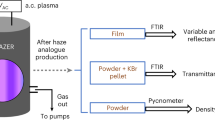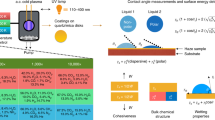Abstract
Sulfur gases substantially affect the photochemistry of planetary atmospheres in our Solar System, and are expected to be important components in exoplanet atmospheres. However, sulfur photochemistry in the context of exoplanets is poorly understood due to a lack of chemical kinetics information for sulfur species under relevant conditions. Here, we study the photochemical role of hydrogen sulfide (H2S) in warm CO2-rich exoplanet atmospheres (800 K) by carrying out laboratory simulations. We find that H2S plays a prominent role in photochemistry, even when present in the atmosphere at relatively low concentrations (1.6%). It participates in both gas and solid phase chemistry, leading to the formation of other sulfur gas products (CH3SH/SO, C2H4S/OCS, SO2/S2 and CS2) and to an increase in solid haze particle production and compositional complexity. Our study shows that we may expect thicker haze with small particle sizes (20–140 nm) for warm CO2-rich exoplanet atmospheres that possess H2S.
This is a preview of subscription content, access via your institution
Access options
Access Nature and 54 other Nature Portfolio journals
Get Nature+, our best-value online-access subscription
$29.99 / 30 days
cancel any time
Subscribe to this journal
Receive 12 digital issues and online access to articles
$119.00 per year
only $9.92 per issue
Buy this article
- Purchase on Springer Link
- Instant access to full article PDF
Prices may be subject to local taxes which are calculated during checkout






Similar content being viewed by others
References
Kreidberg, L. et al. Clouds in the atmosphere of the super-Earth exoplanet GJ1214b. Nature 505, 69–72 (2014).
Knutson, H. A., Benneke, B., Deming, D. & Homeier, D. A featureless transmission spectrum for the Neptune-mass exoplanet GJ 436b. Nature 505, 66–68 (2014).
Knutson, H. A. et al. Hubble space telescope near-IR transmission spectroscopy of the super-Earth HD 97658b. Astrophys. J. 794, 155 (2014).
Lothringer, J. D. et al. An HST/STIs optical transmission spectrum of warm Neptune GJ 436b. Astron. J. 155, 66 (2018).
Dragomir, D. et al. Rayleigh scattering in the atmosphere of the warm exo-Neptune GJ 3470b. Astrophys. J. 814, 102 (2015).
He, C. et al. Photochemical haze formation in the atmospheres of super-Earths and mini-Neptunes. Astron. J. 156, 38 (2018).
Hörst, S. M. et al. Haze production rates in super-Earth and mini-Neptune atmosphere experiments. Nat. Astron. 2, 303–306 (2018).
Marley, M. S. et al. in Comparative Climatology of Terrestrial Planets (eds Mackwell, S. J. et al.) 367–391 (Univ. Arizona Press, 2013).
Morley, C. V. et al. Thermal emission and albedo spectra of super Earths with flat transmission spectra. Astrophys. J. 815, 110 (2015).
Zhang, X., Liang, M. C., Mills, F. P., Belyaev, D. A. & Yung, Y. L. Sulfur chemistry in the middle atmosphere of venus. Icarus 217, 714 (2012).
Titov, D. V., Ignatiev, N. I., McGouldrick, K., Wilquet, V. & Wilson, C. F. Clouds and hazes of Venus. Space Sci. Rev. 214, 126 (2018).
Moses, J. I., Allen, M. & Gladstone, G. R. Post-SL9 sulfur photochemistry on jupiter. Geophys. Res. Lett. 22, 1597–1600 (1995).
Irwin, P. G. J. Cloud structure and composition of Jupiter’s atmosphere. Surv. Geophys 20, 505–535 (1999).
Moses, J. I., Zolotov, M. Y. & Fegley, B. Photochemistry of a volcanically driven atmosphere on Io: sulfur and oxygen species from a Pele-type eruption. Icarus 156, 76–106 (2002).
Moses, J. I. et al. Compositional diversity in the atmospheres of hot Neptunes, with application to GJ 436b. Astrophys. J. 777, 34 (2013).
Hu, R., Seager, S. & Bains, W. Photochemistry in terrestrial exoplanet atmospheres II: H2S and SO2 photochemistry in anoxic atmospheres. Astrophys. J. 769, 6 (2013).
Zahnle, K., Marley, M. S., Freedman, R. S., Lodders, K. & Fortney, J. J. Atmospheric sulfur photochemistry on hot Jupiters. Astrophys. J. 701, L20–L24 (2009).
Zahnle, K., Marley, M. S., Morley, C. V. & Moses, J. I. Photolytic hazes in the atmosphere of 51Eri b. Astrophys. J. 824, 137 (2016).
Gao, P., Marley, M. S., Zahnle, K., Robinson, T. D. & Lewis, N. K. Sulfur hazes in giant exoplanet atmospheres: impacts on reflected light spectra. Astron. J. 153, 139 (2017).
Domagal-Goldman, S. D., Meadows, V. S., Claire, M. W. & Kasting, J. F. Using biogenic sulfur gases as remotely detectable biosignatures on anoxic planets. Astrobiology 11, 419–441 (2011).
He, C. et al. Laboratory simulations of haze formation in the atmospheres of super-Earths and mini-Neptunes: particle color and size distribution. Astrophys. J. Lett. 856, L3 (2018).
He, C. et al. Gas phase chemistry of cool exoplanet atmospheres: insight from laboratory simulations. ACS Earth Space Chem. 3, 39–50 (2019).
Farquhar, J., Savarino, J., Airieau, S. & Thiemens, M. H. Observation of wavelength-sensitive mass-independent sulfur isotope effects during SO2 photolysis: implications for the early atmosphere. J. Geophys. Res. 106, 32829–32839 (2001).
DeWitt, H. L. et al. The formation of sulfate and elemental sulfur aerosols under varying laboratory conditions: implications for early Earth. Astrobiology 10, 773–781 (2010).
Friend, J. P., Leifer, R. & Trichon, M. On the formation of stratospheric aerosols. J. Atmos. Sci. 30, 465–479 (1973).
Ricker, G. R. et al. Transiting exoplanet survey satellite (TESS). J. Astron. Telesc. Instrum. Syst. 1, 014003 (2014).
Butler, R. P. et al. A Neptune-mass planet orbiting the nearby M dwarf GJ 436. Astrophys. J. 617, 580–588 (2004).
Van Grootel, V. et al. Transit confirmation and improved stellar and planet parameters for the super-Earth HD 97658 b and its host star. Astrophys. J. 786, 2 (2014).
He, C. et al. Carbon monoxide affecting planetary atmospheric chemistry. Astrophys. J. Lett. 841, L31 (2017).
McCullough, P. R., Crouzet, N., Deming, D. & Madhusudhan, N. Water vapor in the spectrum of the extrasolar planet HD 189733b. I. The transit. Astrophys. J. 791, 55 (2014).
Sing, D. K. et al. A continuum from clear to cloudy hot-Jupiter exoplanets without primordial water depletion. Nature 529, 59–62 (2016).
Cable, M. L. et al. Titan tholins: simulating Titan organic chemistry in the Cassini-Huygens era. Chem. Rev. 112, 1882–1909 (2012).
Hu, R., Seager, S. & Bains, W. Photochemistry in terrestrial exoplanet atmospheres I: Photochemistry model and benchmark cases. Astrophys. J. 761, 166 (2012).
Domagal-Goldman, S. D., Segura, A., Claire, M. W., Robinson, T. D. & Meadows, V. S. Abiotic ozone and oxygen in atmospheres similar to prebiotic Earth. Astrophys. J. 792, 90–104 (2014).
Rimmer, P. B. & Rugheimer, S. Hydrogen cyanide in nitrogen-rich atmospheres of rocky exoplanets. Icarus 329, 124–131 (2019).
Bar-Nun, A. & Chang, S. Photochemical reactions of water and carbon monoxide in Earth’s primitive atmosphere. J. Geophys. Res. 88, 6662–6672 (1983).
Pinto, J. P., Gladstone, G. R. & Yung, Y. L. Photochemical production of formaldehyde in earth’s primitive atmosphere. Science 210, 183–185 (1980).
Cleaves, H. J. The prebiotic geochemistry of formaldehyde. Precambrian Res. 164, 111–118 (2008).
Schwartz, A. W., Voet, A. B. & Van Der Veen, M. Recent progress in the prebiotic chemistry of HCN. Orig. Life 14, 91–98 (1984).
Sze, N. D. & Ko, M. K. W. Photochemistry of COS, CS2, CH3SCH3 and H2S: implications for the atmospheric sulfur cycle. Atmos. Environ. 14, 1223–1239 (1980).
Kasting, J. F., Zahnle, K. J., Pinto, J. P. & Young, A. T. Sulfur, ultraviolet radiation, and the early evolution of life. Orig. Life Evol. Bio. 19, 95–108 (1989).
Marcq, E., Mills, F. P., Parkinson, C. D. & Vandaele, A. C. Composition and chemistry of the neutral atmosphere of Venus. Space Sci. Rev. 214, 10 (2018).
Hickson, K. M., Loison, J. C., Cavalié, T., Hébrard, E. & Dobrijevic., M. The evolution of infalling sulfur species in Titan’s atmosphere. Astron. Astrophys. 572, A58 (2014).
Ferm, R. J. The chemistry of carbonyl sulfide. Chem. Rev. 57, 621–640 (1957).
Leman, L., Orgel, L. & Ghadiri, M. R. Carbonyl sulfide-mediated prebiotic formation of peptides. Science 306, 283–286 (2004).
Pilcher, C. Biosignatures of early Earths. Astrobiology 3, 471–486 (2003).
Parker, E. T. et al. Prebiotic synthesis of methionine and other sulfur-containing organic compounds on the primitive Earth: a contemporary reassessment based on an unpublished 1958 Stanley Miller experiment. Orig. Life Evol. Bio 41, 201–212 (2011).
Arney, G., Domagal-Goldman, S. D. & Meadows, V. S. Organic haze as a biosignature in anoxic Earth-like atmospheres. Astrobiology 18, 311–329 (2018).
Passerini, R. C. in Organic Sulfur Compounds (ed. Kharasch, N.) 57–74 (Pergamon, 1961).
Eckert, B. & Steudel R. in Elemental Sulfur und Sulfur-Rich Compounds II. Topics in Current Chemistry Vol. 231 (ed. Steudel, R.) 31–98 (Springer, 2003).
Hörst, S. M. & Tolbert, M. A. In situ measurements of the size and density of Titan aerosol analogs. Astrophys. J. Lett. 770, L10 (2013).
Acknowledgements
This work was supported by the NASA Astrophysics Research and Analysis Program NNX17AI87G. X.Y. is supported by a 51 Pegasi b Fellowship. S.E.M. is supported by NASA Earth and Space Science Fellowship 80NSSC18K1109.
Author information
Authors and Affiliations
Contributions
C.H., S.M.H., N.K.L., M.S.M. and J.I.M. conceived the study. J.I.M. calculated the starting gas mixtures. C.H. carried out the experiments and MS measurements. C.H. and X.Y. performed the AFM measurements. C.H. conducted the data analysis and prepared the manuscript. All authors participated in discussions regarding interpretation of the results and edited the manuscript.
Corresponding author
Ethics declarations
Competing interests
The authors declare no competing interests.
Additional information
Publisher’s note Springer Nature remains neutral with regard to jurisdictional claims in published maps and institutional affiliations.
Source data
Source Data Fig. 3
Numerical data used to generate graphs in Fig. 3
Source Data Fig. 4
Numerical data used to generate graphs in Fig. 4
Source Data Fig. 5
Numerical data used to generate graphs in Fig. 5
Source Data Fig. 6
Numerical data used to generate graphs in Fig. 6
Rights and permissions
About this article
Cite this article
He, C., Hörst, S.M., Lewis, N.K. et al. Sulfur-driven haze formation in warm CO2-rich exoplanet atmospheres. Nat Astron 4, 986–993 (2020). https://doi.org/10.1038/s41550-020-1072-9
Received:
Accepted:
Published:
Issue Date:
DOI: https://doi.org/10.1038/s41550-020-1072-9
This article is cited by
-
Optical properties of organic haze analogues in water-rich exoplanet atmospheres observable with JWST
Nature Astronomy (2023)
-
Organic hazes will impact JWST observations of water-rich exoplanets
Nature Astronomy (2023)
-
Haze evolution in temperate exoplanet atmospheres through surface energy measurements
Nature Astronomy (2021)
-
Sulfur Ice Astrochemistry: A Review of Laboratory Studies
Space Science Reviews (2021)



